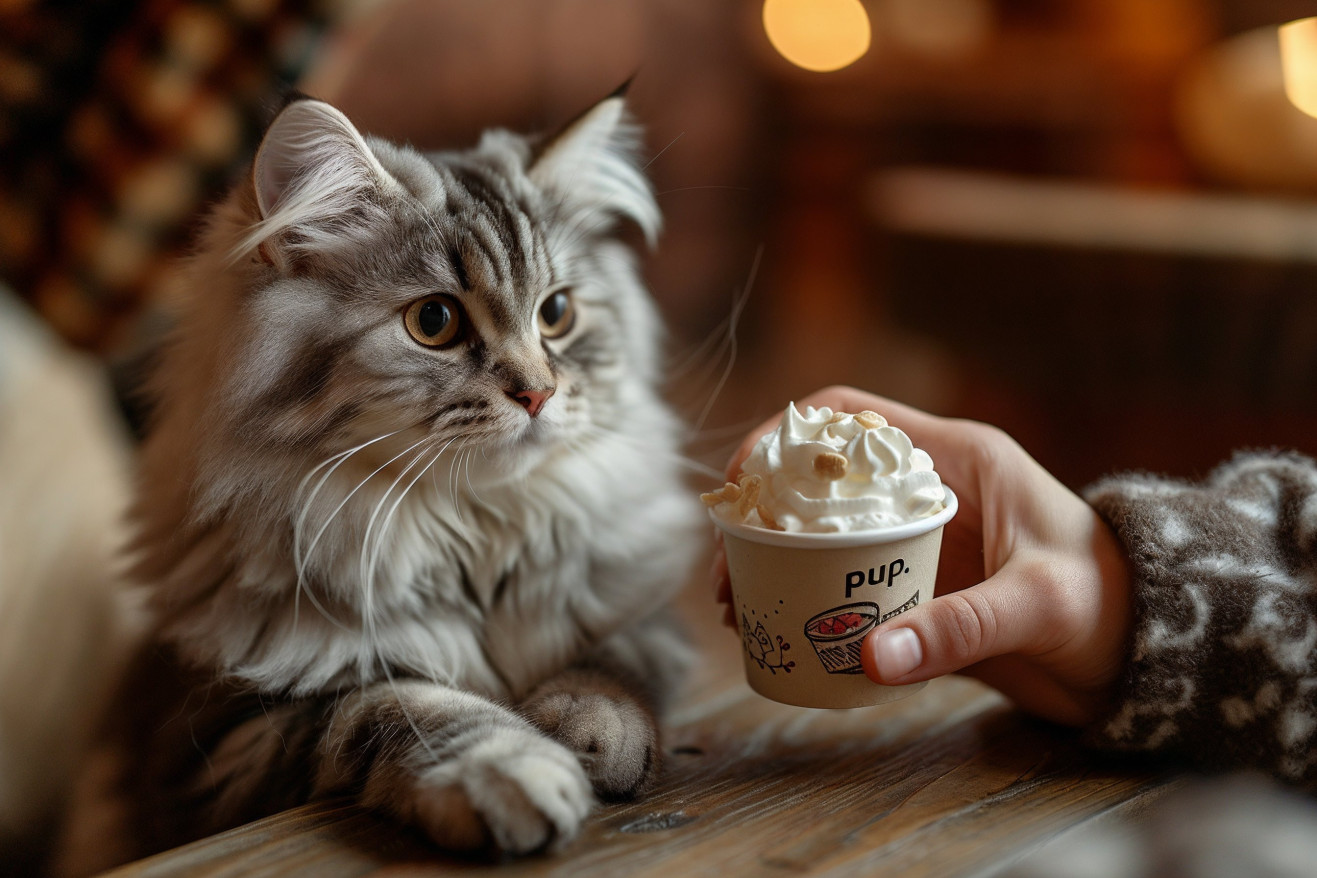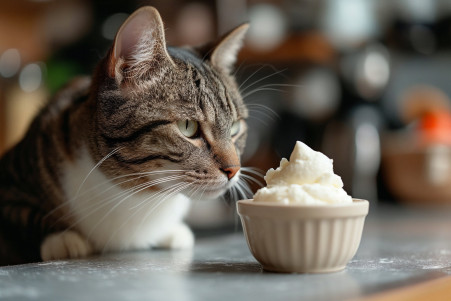Can Cats Eat Pup Cups? Safe Treat Options for Your Cat
1 February 2024 • Updated 2 February 2024

People love to spoil their pets, but can cats eat a pup cup? Pup cups, which are typically small servings of whipped cream, are a popular treat for dogs, but they are not safe for cats. This is because cats are lactose intolerant and eating whipped cream can cause digestive upset and weight gain. Instead, look for treats that are specifically made for cats.
In order to help cat owners make the best choices for their pets, we’ll look at information from veterinarians and research on cat nutrition to find out what cats can and can’t eat. We’ll learn why cats are lactose intolerant, find out what happens when cats eat whipped cream, and offer some safe treat options.
With this information, we hope to help cat owners make the best decisions about what to feed their pets so that they can keep them healthy and happy.
Can cats have pup cups?
Feline Food Allergies
While cats can be hard to understand, they have many of the same food allergies as other pets. According to research in BMC Veterinary Research, the most common food allergens for cats are beef, fish, and chicken.
All of these ingredients are commonly found in human foods and treats, as well as dog treats like ‘pup cups’, and can cause an allergic reaction in cats. When cats consume these allergens, they can experience a variety of symptoms, including skin and gastrointestinal issues, that can affect their health and well-being.
Veterinarians diagnose food allergies in cats with elimination diets, which involve feeding the cat a limited diet to remove potential allergens and then reintroducing foods one by one to see if the cat has a reaction, according to research in the Journal of the American Animal Hospital Association. Food allergies are common in cats, especially when it comes to dermatologic issues.
It’s important to understand how food allergies can affect cats so that you can make sure you’re feeding them things that are safe and healthy. When you take into account the dietary needs of cats, it’s easy to see why certain human foods, including ‘pup cups’, aren’t safe for cats.
Lactose Intolerance in Cats
Lactose intolerance is a common issue for adult cats because they lack the enzyme lactase, which is needed to digest lactose in dairy products. When kittens grow into adults, their lactase production decreases, making them lactose intolerant.
This intolerance is common in adult cats and can cause a variety of digestive problems. A study in Biosciences Biotechnology Research Asia found that diarrhea, vomiting, and dehydration are all signs of lactose intolerance.
Cats’ inability to digest lactose properly makes their intolerance worse when they consume products that contain lactose, like whipped cream, which is often served in small portions in “pup cups.”
As a result, whipped cream can cause problems for lactose-intolerant cats. It’s important to make sure that cat treats don’t contain lactose and instead look for treats that are formulated to meet their dietary needs. Cats can see a difference in their health, often within a few weeks, if they are put on a lactose-free diet. Knowing these dietary requirements can help pet owners make sure their cats stay healthy and happy.
Meeting the Carnivore Diet: Healthy Cat Treats
Cats are obligate carnivores, which means they need a diet that is high in protein and the other nutrients that are found in animal tissue. VCA Animal Hospitals explains that cats have evolved to use protein as their main source of energy, so they need a diet that is high in protein and has the right balance of amino acids.
Cats also need certain nutrients like taurine, arachidonic acid, and preformed vitamin A, which are not present in plant-based foods.
Because of these specific nutritional requirements, it’s important for cat owners to make sure that the treats they give their pets are more than just empty calories. They should be consistent with the cat’s carnivorous nature so that they can support the cat’s health.
According to the RSPCA Knowledgebase, treats that are made from high-quality, nutritionally complete commercial cat foods that are made to manufacturing standards are good choices. Other options like freeze-dried meat treats or small amounts of cooked, lean meats can satisfy the cat’s desire for a treat while also meeting their nutritional needs.
When choosing treats, it’s important to look at both the nutritional content and the safety of the treats. Cat treats that are formulated for cats, free of additives, and low in carbohydrates will meet the cat’s nutritional needs and help to prevent health problems.
By choosing treats that are species-appropriate, you can make sure that you’re not only satisfying your cat’s taste buds but also contributing to their health and well-being, setting the stage for a long, healthy, and happy life.
The Dangers of Feeding Cats Whipped Cream
While giving cats whipped cream may seem like a fun and harmless way to bond with your pet, the nutritional content of whipped cream can lead to a number of health issues. As mentioned, in addition to its appealing texture, whipped cream has no nutritional value for cats and is high in calories, which can contribute to obesity and related conditions like diabetes and dental disease.
Even small amounts of whipped cream can lead to weight gain in cats. Cats don’t have taste buds that register sweetness, so their enjoyment of whipped cream is due to its fat and protein content, not its sugar content.
However, a diet high in dairy fat can lead to obesity, which is a major concern for veterinarians. In addition, some whipped cream brands contain xylitol, an artificial sweetener that is poisonous to cats and can cause liver failure, which will require immediate veterinary treatment.
Because of these risks, it’s important to talk to your vet before giving your cat any new food, including whipped cream. While a small amount of whipped cream may not cause immediate harm, regularly giving cats treats that are not nutritionally appropriate can have long-term consequences. Part of being a good pet owner is understanding these risks and opting for healthier, species-appropriate alternatives.
The Rise of Cat Treats in the Pet Industry
As Petfood Industry notes, the pet treat market has been expanding rapidly, and cat treats have grown by 40% between 2015 and 2020. This growth is due to pet owners’ changing attitudes about their pets’ dietary needs, which have been further influenced by the increase in pet ownership during the COVID-19 pandemic. This has led to a growing demand for pet products, including cat treats, that are safe and meet the specific dietary needs of different animals.
To meet this demand, the pet industry has introduced a variety of cat treats, including those that are lactose-free to accommodate cats’ inability to efficiently digest lactose. As Mintel points out, consumers are increasingly looking for treats that are natural and species-appropriate, which is in line with the dietary needs of obligate carnivores like cats.
This move from one-size-fits-all pet treats to those that are tailored to the dietary needs and preferences of individual species is a big change.
As a result, pet treat manufacturers are now working to balance the desire to create treats that are indulgent with the need to make sure they’re healthy. This means that they’re working to make sure that the treats they create are both tasty and nutritious so that they can contribute to pets’ overall health.
This focus on healthy indulgence means that cat owners can spoil their pets without worrying that they’re negatively impacting their health, a trend that’s likely to continue to shape the pet nutrition market.
So, Can Cats Eat Pup Cups?
Given the risks associated with pup cups, it is not recommended that cat owners feed them to their pets. While dogs may be able to enjoy these sweet, creamy treats, the lactose in them can be harmful to cats, potentially causing digestive problems and other health concerns.
It is well established that cats cannot have whipped cream, the main ingredient in pup cups. Between their lactose intolerance, the risk of obesity, and the potential for exposure to dangerous sweeteners like xylitol, pup cups are a dog treat that cat owners should avoid giving to their pets.
To truly know and understand the dietary needs and limitations of cats is to not only avoid harm but also to support their health and well-being. The wide range of cat-friendly treat options, including those that are species-appropriate and nutritionally valuable, allow us to meet our cats’ carnivorous needs in a way that is safe and healthy.
As responsible pet parents, it is our responsibility to make informed decisions about what we feed our animal companions. By choosing cat treats over pup cups, we are showing that we are dedicated to our pets’ well-being. This is a small but meaningful way to express our love and ensure that our pets are happy and healthy.


